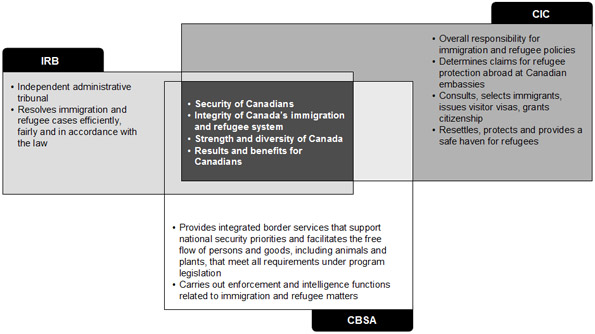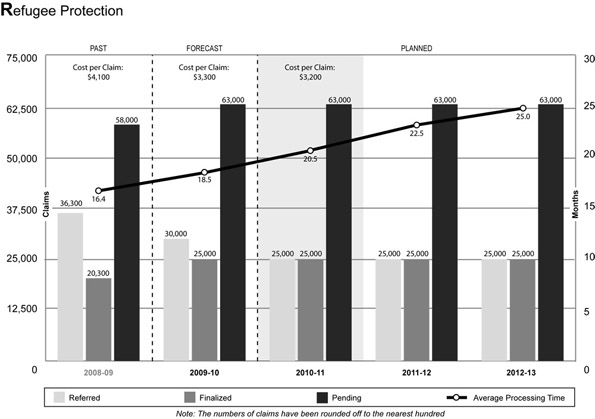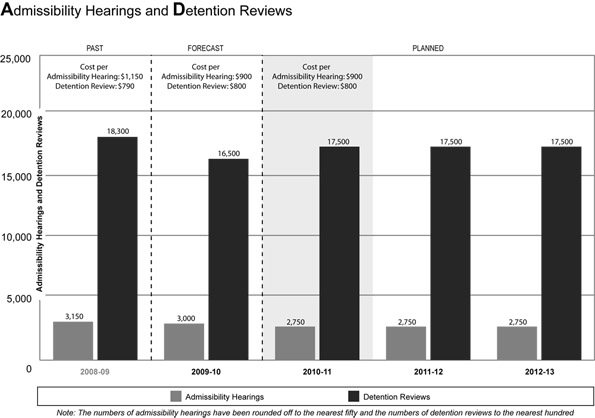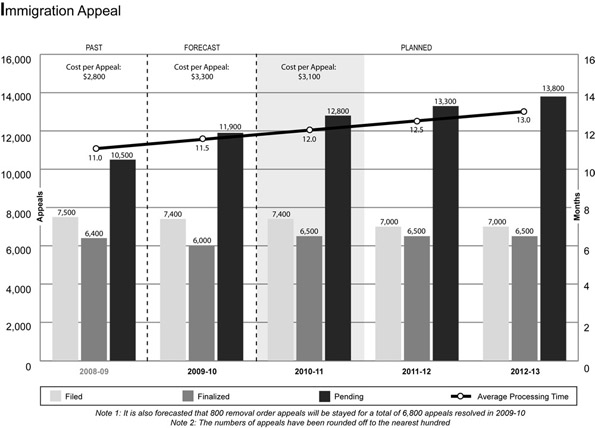ARCHIVED - Immigration and Refugee Board of Canada
 This page has been archived.
This page has been archived.
Archived Content
Information identified as archived on the Web is for reference, research or recordkeeping purposes. It has not been altered or updated after the date of archiving. Web pages that are archived on the Web are not subject to the Government of Canada Web Standards. As per the Communications Policy of the Government of Canada, you can request alternate formats on the "Contact Us" page.
2010-11
Report on Plans and Priorities
Immigration and Refugee Board of Canada
The original version was signed by
The Honourable Jason Kenney
Minister of Citizenship, Immigration and Multiculturalism
Table of Contents
- Raison d'être and Responsibilities
- Strategic Outcome and Program Activity Architecture
- Planning Summary
- Risk Analysis
- Expenditure Profile
Section II – Analysis of Program Activities
- Strategic Outcome and Program Activities
- Program Activity 1: Refugee Protection
- Program Activity 2: Admissibility Hearings and Detention Reviews
- Program Activity 3: Immigration Appeal
- Program Activity 4: Internal Services
Section III – Supplementary Information
Message from the Chairperson

I am pleased to present the 2010-11 Report on Plans and Priorities for the Immigration and Refugee Board of Canada (IRB).
The IRB is an independent, administrative tribunal with important functions within Canada's immigration and refugee determination system. Every day, decision-makers from its three divisions-the Refugee Protection Division (RPD), the Immigration Division (ID) and the Immigration Appeal Division (IAD)—hear and decide matters ranging from refugee claims and admissibility hearings to immigration appeals and detention reviews. The impact of these decisions on the individuals concerned and their families, as well as Canadians generally, is profound, and IRB personnel carry out their work with a keen sense of the responsibility inherent in the Board's mission.
Canadians and persons appearing before the IRB expect it to fulfil its functions with the highest regard for integrity, fairness and efficiency. Since becoming Chairperson, I have pursued a vision for the IRB based on these values, and I am proud of the results we have achieved. By strengthening accountability mechanisms for decision-makers, re-orienting and streamlining the Board's management structures, and promoting enhanced quality and timeliness in decision-making, the IRB is a more effective, integrated organization that is well-positioned to meet the challenges that lie ahead.
Our operating environment
The IRB carries out its work in a complex environment where refugee movements and shifting migration patterns, among other factors, influence the number and type of cases received. All three IRB divisions have experienced high intake levels in recent years. While these levels are expected to remain high in the IAD and the ID in 2010-11, it is projected that the number of cases referred to the RPD will continue to ease as a result of Government policy measures. Nonetheless, the elevated intake has contributed to the growth of substantial backlogs in both the IAD and the RPD, and the RPD's backlog in particular has increased beyond the IRB's capacity to address it within existing resource levels.
The IRB has worked closely with the Minister of Citizenship, Immigration and Multiculturalism, his staff and the Privy Council Office over the past year to address the shortfall in the complement of Governor in Council decision-makers. These efforts have allowed the Board to return to a nearly full complement in the RPD and the IAD. Although a large proportion of decision-makers in both divisions have only recently been appointed, we nevertheless expect to resolve 25,000 refugee protection claims and 6,500 immigration appeals in 2010-11 through improved case management.
Focus on innovation
Over the past several years, the IRB has pursued operational and adjudicative efficiencies to increase productivity in its three divisions without sacrificing fairness. While these efforts will continue in 2010-11, the adoption of further efficiency measures will only allow us to stop the growth of the RPD backlog. Additional resources are required to substantially reduce or eliminate the accumulated inventory.
Key priorities for 2010-11
We have identified the following two strategic priorities for 2010-11 that build on those from the previous fiscal year:
- Continue to maximize case resolutions while ensuring quality and fairness;
- Continue to promote an adaptive, integrated and flexible organization that values its people.
In line with these strategic priorities, we will focus on both ongoing and new initiatives in the year ahead. These include:
- Continue recruitment of needed personnel;
- Strengthen management practices in targeted areas;
- Continue to develop options to address the case backlogs;
- Further enhance adjudicative support to ensure that files are hearing-ready;
- Implement and monitor quality standards for decision-making and support;
- Implement the results of Strategic Review;
- Prepare for implementation of possible legislative reform;
- Continue to engage with key partners, stakeholders and personnel.
Looking ahead
In 2010-11, we will continue to integrate our operations to become a more flexible organization while recognizing that the implementation of Strategic Review and the possibility of refugee reform may greatly influence our operating environment. I invite you to read this report and to visit our Web site at www.irb-cisr.gc.ca for more information.
Brian Goodman
Chairperson
Section I – Overview
Raison d'être and Responsibilities
The IRB is an independent administrative tribunal that was created on January 1, 1989, by an amendment to the Immigration Act.
Our mission, on behalf of Canadians, is to resolve immigration and refugee cases efficiently, fairly and in accordance with the law
In 2002, the Immigration Act was replaced by the Immigration and Refugee Protection Act (IRPA) from which each IRB division gets its mandate.
| Refugee Protection Division (RPD) |
|---|
|
| Immigration Division (ID) |
|
| Immigration Appeal Division (IAD) |
|
An overview of the IRB is available at http://www.irb-cisr.gc.ca/eng/brdcom/publications/oveape/Pages/index.aspx
Regional Operations
The IRB carries out its work in three regional offices in Toronto, Montréal and Vancouver: the Central Region, responsible for Ontario, except for the Ottawa area; the Eastern Region, responsible for Quebec, the National Capital Region and the Atlantic provinces; and the Western Region, responsible for the Western provinces. All three divisions hold hearings in these regions, supported by adjudicative and corporate support. The IRB also has offices in Calgary and Ottawa in which hearings are held. Internal and support services are managed at IRB Headquarters, located in Ottawa.
Administrative Justice
Through each division, the IRB strives to deliver a simpler, more accessible and expeditious form of justice than that provided by the courts, but with no less attentiveness to procedural fairness, the rigour of the law and its application to the particular facts of each case. The IRB applies the principles of administrative law, including those of natural justice, in its proceedings and resolutions, and decisions are rendered in accordance with the law, including the Canadian Charter of Rights and Freedoms.
The IRB is committed to fairness in all aspects of its work. The Board respects the dignity and diversity of individuals who appear before it, some of whom have experienced very difficult circumstances.
Benefits for Canadians
Immigrants and refugees have always contributed significantly to Canada's growth and development. The IRB ensures continued benefits to Canadians in three important ways:
- In the hearing of refugee claims, it ensures that Canada accepts those in need of protection in accordance with international obligations and Canadian law;
- Through admissibility hearings and detention reviews, it helps to ensure the security of Canadians;
- As an independent tribunal responsible for resolving sponsorship, removal order and residency obligation appeals, it helps to promote family reunification, helps to ensure Canadians' safety and security, and safeguards the integrity of Canada's immigration system.
The IRB also contributes more broadly to the quality of life of Canada's communities by strengthening our country's social fabric and by reflecting and reinforcing core values that are important to Canadians. These include respect for human rights, peace, security and the rule of law.
Strategic Outcome and Program Activity Architecture (PAA)
Based on its legislated mandate and its currently approved PAA, the IRB has a single strategic outcome and three program activities that include responsibility for all tribunal decisions and resolutions. The fourth program activity, Internal Services, supports the first three as illustrated by the figure below.

Planning Summary
| 2010-11 | 2011-12 | 2012-13 |
|---|---|---|
| 117.1 | 116.9 | 116.9 |
| 2010-11 | 2011-12 | 2012-13 |
|---|---|---|
| 1,025 | 1,025 | 1,025 |
|
Strategic Outcome Resolve immigration and refugee cases before the Immigration and Refugee Board of Canada efficiently, fairly and in accordance with the law |
|
| Performance Indicators In addition to the productivity indicators described for each of the program activities (see Section II), the following quality indicator will be used: - Percentage of IRB decisions overturned by the Federal Court |
Target - Less than 1% |
|---|---|
| Program Activity 1 | Forecast Spending ($ Millions) |
Planned Spending 2 ($ Millions) |
Alignment to Government of Canada | ||
|---|---|---|---|---|---|
| 2009-10 | 2010-11 | 2011-12 | 2012-13 | ||
| Refugee Protection Program Activity | 58.9 | 57.9 | 57.8 | 57.8 | A safe and secure world through international cooperation |
| Admissibility Hearings and Detention Reviews Program Activity | 8.6 | 12.7 | 12.7 | 12.7 | A safe and secure Canada |
| Immigration Appeal Program Activity | 16.9 | 14.6 | 14.6 | 14.6 | A vibrant Canadian culture and heritage 3 |
| Internal Services Program Activity | 31.0 | 31.9 | 31.8 | 31.8 | |
| Total Planned Spending | 115.4 | 117.1 | 116.9 | 116.9 | |
1: For program activity descriptions, please refer to Section II or access the Main Estimates online at http://www.tbs-sct.gc.ca/est-pre/index-eng.asp.
2: Planned Spending is based on the IRB submission for the Main Estimates and does not include possible reductions or reinvestments resulting from the Strategic Review that will be finalized after the deadline for this report.
3: Through its removal orders work, the Immigration Appeal program activity also contributes to the Government of Canada outcome "A Safe and Secure Canada".
IRB Strategic Priorities
The IRB's two strategic priorities for 2010-11 are summarized in the table below. Supporting the same single strategic outcome, these priorities have evolved from priorities identified in previous years. During 2010-11, efforts will continue in order to further improve the Board's practices and achieve even better results for Canadians.
| Priorities | Type | Description |
|---|---|---|
| Continue to maximize case resolutions while ensuring quality and fairness | Operational Ongoing |
The IRB will continue to assess and recommend qualified candidates to the Minister for appointment in order to maintain a full complement of Governor in Council (GIC) decision-makers. Learning and training programs will be further enhanced. The Board will continue to develop options to address the pending case inventory and pursue resources to implement backlog reduction strategies. The IRB will also implement and monitor quality measurement standards for decision-making as well as adjudicative support. |
| Continue to promote an adaptive, integrated and flexible organization that values its people | Management Ongoing |
The IRB will continue to ensure the consistent delivery of high-quality administrative justice within a changing environment. In 2010-11, the IRB will have to adapt to the changes brought about by the Strategic Review and the possibility of reform to the refugee determination system. The Board will further integrate its operations. Emphasis will also be placed on human resources management practices. |
Risk Analysis
Operating Environment
The IRB carries out its mandate within a complex and ever-changing environment. Both international and domestic factors influence the IRB's operating environment. Conflicts and country conditions abroad can result in refugee movements, which affect the number of refugee protection claims made in Canada. Similarly, shifts in international migration patterns and changes to domestic policies by other receiving countries impact the number of people seeking admission to Canada.
Refugee populations. The report Asylum Levels and Trends in Industrialized Countries, First Half 2009, published by the United Nations High Commissioner for Refugees (UNHCR), shows that the number of asylum claims submitted in the 44 main industrialized countries continued the upward trend observed in the past two years. An estimated 185,500 applications were recorded during the first six months of 2009, 10 percent more than during the same period in 2008. If recent patterns in asylum applications remain unchanged, including historically higher numbers of claims in the second half of the year, the UNHCR predicts that the number of asylum claims submitted in the 44 surveyed countries may reach 400,000 during 2009.
Following the United States and France, Canada was the third largest recipient of applications among the 44 countries with 18,700 new asylum claims registered during the first half of 2009. This is an increase of 11 percent compared to the second half of 2008 (16,800 claims). The increase can largely be attributed to more Czechs and Hungarians requesting protection in Canada.
Despite the UNHCR's projection, the large number of referrals to the IRB was slowed following the Government's imposition of a visa requirement for Mexican and Czech citizens wishing to travel to Canada. This policy measure came into effect in mid-July 2009, and had a direct impact on protection claim referrals from these two high-volume source countries. As of January 2010, the IRB is projecting that its intake of refugee protection claims will decrease from 30,000 in 2009-10 to 25,000 in 2010-11, a reduction of 15 percent.
Growing trend of family sponsorships. Immigrants in Canada are expected to number between 7.0 and 9.3 million by 2017. It is within this context, and consistent with the Government's objective of promoting family reunification, that family class sponsorship applications have increased. With this increase, it is expected that the IRB will continue to receive a high number of family sponsorship appeals.
Challenges
Appointment of decision-makers. In order to resolve the refugee protection claims and immigration appeals referred to it, the IRB depends on decision-makers appointed by the GIC following a rigorous merit-based selection process. As noted in the 2009 Status Report of the Auditor General of Canada, during a series of transitions in government between 2004 and 2008, appointments and reappointments of GIC decision makers to the Board did not keep pace with vacancies resulting from expired mandates and resignations. This had a significant impact on the Board's capacity to process cases on a timely basis. By December 2009, this situation was largely corrected with an increased number of GIC decision-maker appointments and reappointments. During 2009, there were 60 appointments and 23 reappointments. The RPD and the IAD are expected to be close to full complement by the beginning of 2010-11. Although both divisions will have a large proportion of new decision-makers, the IRB anticipates finalizing 25,000 refugee protection claims and 6,500 immigration appeals during the reporting period, due to improved training and recent productivity increases.
Pending case inventory. There will be approximately 63,000 refugee protection claims and 11,900 immigration appeals pending at the beginning of the 2010-11 reporting period. This inventory has become progressively larger over the last three years, and results primarily from two external factors outside the IRB's control: an increased number of refugee protection claims referred and immigration appeals filed; and the shortfall in the IRB's GIC decision-maker complement. While the IRB will continue to pursue innovative strategies to further increase its productivity, such opportunities are becoming increasingly limited. Changes to resource levels are required in order to substantially reduce the inventory accumulated in the RPD or return it to normal operating levels.
Strategic review. On a four-year cycle, the Government carries out a review of program expenditures of departments and agencies with a view to identifying lower priority program funding that could be reallocated to higher Government priorities. The IRB began the cycle during 2009-10 and, as required by the review process, identified 5 percent of its budget for possible reallocation to other government priorities and also identified priority areas for possible reinvestment within the IRB. Government decisions on this review could affect the IRB's budget for three years, beginning in 2010-11. However, the results will only be known after the deadline for submission of this report. For this reason, the financial data presented in this report are based on the IRB submission for the Main Estimates and do not include possible reductions or reinvestments associated with the Strategic Review. The review may result in the IRB having its budget reduced by as much as 5 percent, or increased by government decisions on priority reinvestments, or a combination of both. The IRB will adjust its business plan at the beginning of 2010-11, once the results of the review are announced.
Reform to the refugee protection framework. At the time of publication of this report, the Government has stated its intention to reform the refugee protection system. Legislative changes in this regard would influence the IRB's operating environment and have an additional impact on the IRB's processes and internal resource allocations. Once legislation to reform the refugee protection system is tabled in Parliament, the IRB will closely assess the impact of the proposed measures and develop a detailed implementation plan. Implementation timelines will depend on the legislative process, Royal Assent and funding decisions.
Opportunities
Portfolio and stakeholders. As immigration and refugee portfolio partners, the IRB, CIC and the Canada Border Services Agency (CBSA) collaborate on operational matters while respecting each other's distinct mandates and the IRB's institutional and adjudicative independence. Portfolio organizations are subject to a trilateral Memorandum of Understanding that provides a framework under which organizational priorities are discussed and information is shared as appropriate. This collaborative approach provides for improved communication and operational coordination. The diagram below outlines the distinct functions and roles of the portfolio organizations as well as the overarching goals they share in common. During 2010-11, the IRB will continue to engage with portfolio partners and stakeholders in order to effectively implement its priorities and key initiatives.
Expenditure Profile
Spending Trend 2006-07 to 2012-13

Lower actual spending in 2007-08 was primarily due to delays in appointments and reappointments of GIC decision-makers and vacant public service positions. This resulted in fewer decisions rendered and translated than estimated.
The planned spending for 2010-11 and beyond is expected to remain constant; however, it does not reflect the potential reductions or reinvestments that could result from the Strategic Review, which will only be approved after the production of this report.
Allocation of Funding by Program Activity
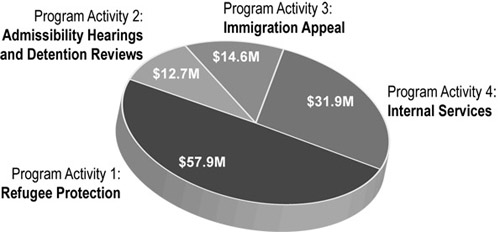
Voted and Statutory Items
| Vote Number or Statutory Items (S) | Truncated Vote or Statutory Wording | 2009-10 Main Estimates ($ Millions) |
2010-11 Main Estimates ($ Millions)* |
|---|---|---|---|
| 10 | Program expenditures | 100.8 | 104.0 |
| (S) | Contributions to employee benefit plans | 12.6 | 13.1 |
| Total | 113.4 | 117.1 | |
* Planned Spending numbers are based on the IRB submission for the Main Estimates and do not include possible reductions or reinvestments resulting from the Strategic Review that will be finalized after the deadline for this report.
Section II – Analysis of Program Activities
This section provides detailed information on the plans and expected results as well as financial and human resources for the IRB's four program activities.
Strategic Outcome and Program Activities
As discussed in Section I, based on the IRB's legislated mandate and approved PAA, the IRB has a single strategic outcome and three program activities that include responsibility for all tribunal decisions and resolutions. These are supported by Internal Services, which is the fourth program activity.
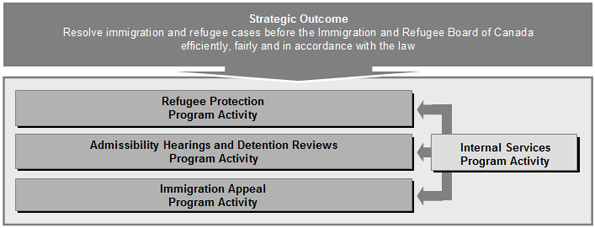
IRB program activities are designed to support the achievement of the strategic outcome. The following pages further describe these program activities, identifying expected results, performance indicators and targets, as well as outlining the resources dedicated to each of the four activities.
Program Activity 1: Refugee Protection
The Refugee Protection Division (RPD) delivers the IRB's Refugee Protection program activity. It determines claims for refugee protection made in Canada. Processing of refugee claims is the main focus of the IRB's activities and resources. Through the work of the RPD, Canada fulfils its obligations as a signatory to a number of international human rights conventions.
Additional information on the RPD is available at
http://www.irb-cisr.gc.ca/eng/tribunal/rpdspr/pages/index.aspx
| Human Resources (FTEs) and Planned Spending ($ Millions) | |||||
|---|---|---|---|---|---|
| 2010-11 | 2011-12 | 2012-13 | |||
| FTEs | Planned Spending | FTEs | Planned Spending | FTEs | Planned Spending |
| 565 | 57.9 | 565 | 57.8 | 565 | 57.8 |
| Expected Result | |
|---|---|
| Quality decisions rendered and cases resolved in a timely manner regarding refugee protection claims made in Canada | |
| Performance Indicators | Targets |
| Clarity, completeness and conciseness of IRB reasons for decisions | Target under development at the time of publishing this report. |
| Percentage of cases finalized without a hearing | It is expected that 6 to 8% of cases will meet the criteria to be finalized without a hearing, through more expeditious processes. |
| Ratio of finalized cases to referred cases | Approximately 25,000 refugee protection claim referrals are expected to be received in 2010-11. Because it is assumed that the RPD will be at its funded decision-maker complement for the fiscal year, finalizations are expected to be 25,000 claims. This will result in a ratio of finalized-to-referred cases of 100%. |
| Average cost per claim finalized | $3,200 |
| Average case processing time | The average processing time (from referral to finalization) could increase to 20.5 months as the age of the cases in the inventory continues to grow. |
2010-11 Planning Highlights
Decision-makers. At the time of the writing of this report, it is expected that the RPD will be very close to its full complement of decision-makers by the beginning of 2010-11. This represents a marked change from the previous two fiscal years, throughout which there were significant vacancies in the RPD's decision-making complement. However, active recruitment will remain a priority activity for the Board as 28 decision-makers will reach the end of their mandate during 2010-11. Any delay in the timely reappointment or replacement of decision-makers at the end of their mandates will have an impact on the Division's productivity. Moreover, with 68 percent of decision-makers in their first mandate, effective, timely and tailored training remains a priority for the IRB.
Inventory. There will be 63,000 refugee protection claims waiting to be heard by the beginning of 2010-11. This accumulated inventory is well beyond the Division's capacity to address within existing resource levels. For 2010-11, referrals and finalizations are expected to become fairly balanced (both at 25,000 claims), resulting in no further increase to the number of pending cases. Without additional resources, the accumulated inventory is expected to remain relatively unchanged by the end of the 2010-11 reporting period.
Case management. Case management efficiencies, including enhanced adjudicative support, continued hearing-readiness efforts, and more focused monitoring of postponements and adjournments, will allow productivity to remain high despite the fact that the majority of the decision-maker complement is relatively inexperienced.
Quality. During 2010-11, the RPD will continue to deliver fair and high-quality decisions and reasons. Quality improvements will come from clearly communicated performance standards and associated monitoring, appropriate use of videoconferencing and the increased use of recently implemented decision-making tools. In the year ahead, the RPD will continue to be an adaptive, integrated and flexible tribunal.
Benefits for Canadians
Through the work of the Refugee Protection program activity, Canada accepts only those refugee claimants who are in need of protection. Canada provides a safe haven to persons with a well-founded fear of persecution as well as to those facing a danger of torture or a risk to their life, or a risk of cruel and unusual treatment or punishment if returned to their country of origin. This contributes to a safe and secure world environment.
Program Activity 2: Admissibility Hearings and Detention Reviews
The Immigration Division (ID) delivers the Admissibility Hearings and Detention Reviews program activity. It holds hearings for foreign nationals or permanent residents who, under the provisions of the IRPA, are alleged to be inadmissible to Canada or are detained. Detainees must be seen by the ID within 48 hours after their referral, or without delay thereafter, and subsequent reviews must be conducted within specific statutory timeframes. Decision-makers must balance the right to individual liberty with the safety and security interests of Canadians.
Additional information on the ID is available at
http://www.irb-cisr.gc.ca/eng/tribunal/idsi/pages/index.aspx
| Human Resources (FTEs) and Planned Spending ($ Millions) | |||||
|---|---|---|---|---|---|
| 2010-11 | 2011-12 | 2012-13 | |||
| FTEs | Planned Spending | FTEs | Planned Spending | FTEs | Planned Spending |
| 70 | 12.7 | 70 | 12.7 | 70 | 12.7 |
| Expected Result | |
|---|---|
| Quality decisions rendered and cases resolved in a timely manner regarding admissibility hearings and detention reviews | |
| Performance Indicators | Targets |
| Clarity, completeness and conciseness of IRB reasons for decisions | Target under development at the time of publishing this report. |
| Percentage of admissibility hearing cases concluded to referred cases | 98% (Detention reviews take priority over admissibility hearings due to legislative time requirements. The number of referrals from the CBSA affects the capacity to conduct admissibility hearings.) |
| Percentage of concluded detention review cases within statutory timeframe | 97% (Factors outside the IRB's control, such as prison lock-downs, impede the achievement of 100% compliance.) |
| Average cost of admissibility hearing | $900 |
| Average cost of detention review | $800 |
| Percentage of admissibility hearings concluded with a hearing within six months from referral | 88% (The number of detention review referrals from the CBSA and the complexity of a growing number of cases affect the capacity to conclude admissibility hearings within the six-month target.) |
2010-11 Planning Highlights
Sustained and more complex workload. The number of cases concluded by the ID depends largely on the number of cases referred by the CBSA. Over the past three years, referrals for admissibility hearings have increased by 27 percent while referrals for detention reviews have increased by 4 percent. In addition, a growing number of admissibility hearings involve more complex and novel issues. However, through continued efficiencies, the ID has increased its output within existing resources and has been able to conclude cases within the legislated timeframe for detention reviews.
During 2010-11, it is anticipated that the ID will continue to experience a moderate decrease in referrals for admissibility hearings while the number of detention reviews will remain high but stable. The ID will continue to prioritize detention reviews to ensure that legislative requirements and fundamental rights are respected.
Effective case management. In order to manage its case inventory, the ID will monitor its scheduling standards to ensure that determined productivity targets are being met. The further enhancements of effective case management practices will allow the ID to maintain reduced adjournment and postponement rates, to reduce processing times, and to increase its capacity to resolve cases in a timely fashion. A sample of decisions will also be selected for quality review; the results of this review will serve to improve and refine training programs.
More focused monitoring of efficiency standards will allow the Division to reduce the number of admissibility hearings that are pending for more than six months and finalize the vast majority of new cases within a six-month timeframe.
Through ongoing communication and effective management, the ID will foster a work environment that builds on the individual skills and talents of its people.
Benefits for Canadians
The ID renders decisions that maintain the security of Canadian society and uphold Canada's reputation for justice and fairness to individuals. Through its work on admissibility hearings and detention reviews, the ID contributes to the maintenance of the balance between individual rights and the safety and security of Canadians.
Program Activity 3: Immigration Appeal
The Immigration Appeal Division (IAD) delivers the Immigration Appeal program activity. It hears immigration appeals from Canadian citizens and permanent residents whose applications to sponsor close family members to Canada have been refused. Other key functions include hearing appeals from permanent residents, foreign nationals with a permanent resident visa, protected persons who have been ordered removed from Canada, and permanent residents outside Canada who are alleged to have not fulfilled their residency obligation.
Additional information on the IAD is available at
http://www.irb-cisr.gc.ca/eng/tribunal/iadsai/pages/index.aspx
| Human Resources (FTEs) and Planned Spending ($ Millions) | |||||
|---|---|---|---|---|---|
| 2010-11 | 2011-12 | 2012-13 | |||
| FTEs | Planned Spending | FTEs | Planned Spending | FTEs | Planned Spending |
| 120 | 14.6 | 120 | 14.6 | 120 | 14.6 |
| Expected Result | |
|---|---|
| Quality decisions rendered and cases resolved in a timely manner regarding immigration appeals | |
| Performance Indicators | Targets |
| Clarity, completeness and conciseness of IRB reasons for decisions | Target under development at the time of publishing this report. |
| Percentage of appeals finalized without a hearing | It is expected that 43% or more appeals will be finalized without a hearing. |
| Ratio of finalized appeals to filed appeals | Approximately 7,400 appeals are expected to be filed in 2010-11. Based on the number of decision-makers available, we expect to finalize 6,500 appeals. This will result in a ratio of finalized-to-filed appeals of 88%. |
| Average cost per appeal finalized | $3,100 |
| Average appeal processing time | Based on the inventory, it is expected that the average processing time could increase to 12 months in 2010-11. |
2010-11 Planning Highlights
Decision-makers. In 2010-11, the IAD expects to be close to its full complement of decision-makers. Despite the fact that the majority of IAD decision-makers will be in their first mandate, with several in their initial training period, the Division expects to achieve a high level of productivity.
Inventory. The IAD is forecasting an intake of 7,400 filed appeals for 2010-11. The inventory of appeals awaiting finalization will increase slightly to 12,800. The Division will continue to identify efficiencies in its procedural, adjudicative and administrative practices and, as new decision-makers become more experienced, productivity will increase.
Case management. The IAD will continue to respond in a flexible manner to match resources with regional caseloads by sharing decision-makers among regions and by conducting hearings via videoconference where appropriate. Case management strategies will focus on increasing early resolution of appeals without a hearing, enhancing hearing readiness, scheduling appeals strategically to increase efficiencies, and monitoring reasons for postponements and adjournments. The IAD remains committed to producing quality decisions that are made in a timely manner.
Portfolio linkages. The IAD will continue to work with the CBSA to quickly finalize appeals that the CBSA has screened for early resolution and to facilitate the hearing of appeals where the Minister's counsel has chosen to participate through written submissions only. Work undertaken with the CBSA on case management innovations will continue, as always, to respect the adjudicative independence of IAD decision-makers.
Benefits for Canadians
Through its sponsorship appeals work, the IAD recognizes the contributions of immigrants to the strength and vitality of Canadian society and culture, as well as the Government's commitment to family reunification. Through its work on removal order appeals, the IAD enhances public safety while ensuring that individuals' fundamental rights are respected.
Program Activity 4: Internal Services
Internal Services are groups of related activities and resources required to support the needs of all three tribunal programs and other corporate obligations of the IRB. These services are: Management and Oversight; Communications; Legal; Human Resources Management; Financial Management; Information Management; Information Technology; Materiel; Acquisition; and Other Administrative Services. Internal Services include only those activities and resources that apply across an organization and not to those provided to a specific program.
| Human Resources (FTEs) and Planned Spending ($ Millions) | |||||
|---|---|---|---|---|---|
| 2010-11 | 2011-12 | 2012-13 | |||
| FTEs | Planned Spending | FTEs | Planned Spending | FTEs | Planned Spending |
| 270 | 31.9 | 270 | 31.8 | 270 | 31.8 |
2010-11 Planning Highlights
Management and oversight. During 2010-11, the IRB will focus on two specific areas of management and oversight: staffing of human resources and oversight of systems development:
- As a result of the Public Service Commission (PSC) audit of the IRB's staffing activities, the Board recognizes that human resource management practices must be strengthened across the organization, particularly in the area of staffing, to ensure compliance with the Public Service Employment Act (PSEA), the PSC Appointment Framework and other governing authorities. This will involve a collective effort on the part of the entire management team to address the issues identified in the audit report in a rigorous, timely and transparent manner. We will also continue to develop monitoring frameworks in the areas of classification, staffing and compensation to identify and address areas for improvement.
- In October 2009, the IRB contracted with an outside firm to carry out an on-going independent review of the IRB's System for Tracking Appeals and Refugees (STAR) Modernization Project. The purpose of the review is to confirm that the IRB has a full and complete understanding of the project parameters, how work on the project will be undertaken, and the dependencies inherent in its successful completion. Independent reviewers from this outside firm will also serve as advisors to IRB senior management throughout 2010-11 and the life of the project.
Communications. The IRB will continue to engage with key partners, national and international stakeholders, and the public through its Outreach and Communications programs and international activities. Through its work in this area, the IRB will facilitate information sharing and enhance understanding of its mandate and operations to aid in implementing its key initiatives and priorities.
Legal. Legal Services will focus its activities on providing training and support to the large number of newly appointed decision-makers and offering advice, including risk analysis, regarding innovative adjudicative strategies and their implementation in support of the Board's inventory management. Legal Services will also continue to provide substantial support and advice on complex cases involving classified information related to national security or criminal intelligence. With the possibility of refugee reform, Legal Services will also ensure that any proposed new aspects of operations, service delivery, policy development, corporate direction and management decisions are in compliance with all relevant legal requirements.
Human resources management. The IRB fosters an environment where people management is valued and recognized as a priority in achieving its strategic outcome. During 2010-11, the IRB will continue to build its capacity to fulfil its human resources needs in a timely and effective manner. The Board will continue to act on the PSC's recommendations in the 2009 audit. The IRB is committed to conducting staffing activities which respect merit as well as the core and guiding values of the public service, in accordance with the PSEA.
Financial management. The IRB will focus its efforts on implementing the new suite of Treasury Board Secretariat (TBS) financial policies and directives including the Policy on Internal Control and its specific requirements related to financial reporting. These include impact analysis, amendments to existing internal processes and practices, development of new or amendments to existing directives and procedures, communications, and training.
Information management. The information management section will finish implementing the new IRB function-based classification structure. The role of the IRB Chief Information Officer (CIO) will be defined and the internal mechanisms that will support the CIO will be instituted.
Information technology. Information Technology (IT) at the IRB is shaped by new and emerging business priorities and on-going systems and infrastructure maintenance and upgrades. In 2010-11, IT efforts will focus on the successful release and implementation of the Interactive Scheduling Interface, a new scheduling tool for the RPD, and the effective and timely development of the STAR Modernization Project for the RPD and IAD.
Procurement and assets management. The IRB will continue to strengthen its procurement functions through the mandatory course Overview of Procurement offered by the Canada School of Public Service. We will improve internal processes to further eliminate duplication of effort. In addition, we will implement new green policies and procedures to ensure effective, efficient, accountable and environmentally-responsible activities related to the life-cycle management of the IRB's assets.
Internal audit. In 2009-10, the IRB's internal audit structure was reorganized to conform to the Treasury Board's Internal Audit Policy requirements. In 2010-11, a new internal audit policy will be developed as well as a three-year risk-based audit plan that reflects the IRB's changing environment. The newly established IRB Audit Committee will continue to strengthen its capacity and provide the Chairperson with objective advice and assurance on the adequacy of IRB's control and accountability processes.
Evaluation. The IRB is currently implementing key recommendations of a recent evaluation to improve the effectiveness and efficiency of its scheduling practices. At the same time, the IRB is laying the groundwork for its five-year departmental evaluation plan based on risk, evaluation needs and on the requirements set out by the TBS. This plan will expand the performance measurement framework to include indicators of decision-making quality and internal services.
Section III – Supplementary Information
Supplementary Information Tables
All electronic supplementary information tables found in the 2010-11 Report on Plans and Priorities is available on the TBS Web site at
http://www.tbs-sct.gc.ca/rpp/st-ts-eng.asp.
- Green Procurement
- Upcoming Internal Audits and Evaluations over the next three fiscal years
Other Items of Interest
Legislation Administered
Immigration and Refugee Protection Act (S.C. 2001, c. 27, as amended)
Immigration and Refugee Protection Regulations (SOR/2002-227, as amended)
Refugee Protection Division Rules (SOR/2002-228)
Immigration Division Rules (SOR/2002-229)
Immigration Appeal Division Rules (SOR/2002-230)
Oath or Solemn Affirmation of Office Rules (Immigration and Refugee Board of Canada) (SOR/2002-231)
IRB Processes
Visit these links to find out how the IRB processes its cases:
- Refugee Protection Claim Process
http://www.irb-cisr.gc.ca/en/references/procedures/processes/rpd/rpdp_e.htm - Admissibility Hearing Process
http://www.irb-cisr.gc.ca/en/references/procedures/processes/id/ahp_e.htm - Detention Review Process
http://www.irb-cisr.gc.ca/en/references/procedures/processes/id/drp_e.htm - Sponsorship Appeal Process
http://www.irb-cisr.gc.ca/en/references/procedures/processes/iad/sap_e.htm - Removal Order Appeal Process
http://www.irb-cisr.gc.ca/en/references/procedures/processes/iad/roap_e.htm - Residency Obligation Appeal Process
http://www.irb-cisr.gc.ca/en/references/procedures/processes/iad/resoap_e.htm
Related Information
UNHCR Web site: http://www.unhcr.org/home.html
Contact us
For more information, visit the IRB Web site at http://www.irb-cisr.gc.ca or contact the IRB Communications Directorate at 613-947-0803 or one of the IRB offices listed below.
National Headquarters
Immigration and Refugee Board of Canada
Minto Place—Canada Building
344 Slater Street, 12th Floor
Ottawa, Ontario K1A 0K1
Tel: 613-995-6486 Fax: 613-943-1550
Regional Offices
Eastern Region
200 René Lévesque Boulevard West
Guy-Favreau Complex
East Tower, Room 102
Montreal, Quebec H2Z 1X4
Tel: 514-283-7733 Fax: 514-283-0164
Central Region
74 Victoria Street, Suite 400
Toronto, Ontario M5C 3C7
Tel: 416-954-1000 Fax: 416-954-1165
Western Region
Library Square, Suite 1600
300 West Georgia Street
Vancouver, British Columbia V6B 6C9
Tel: 604-666-5946 Fax: 604-666-3043
